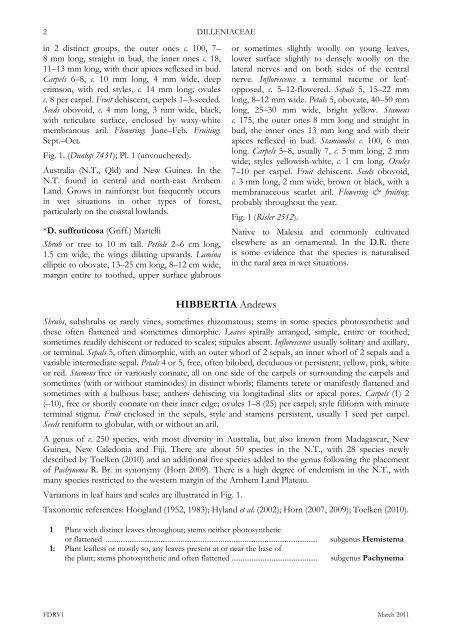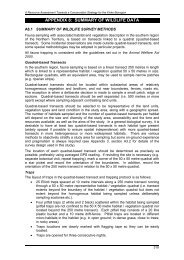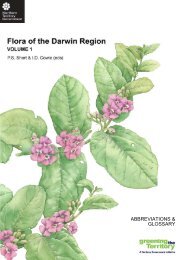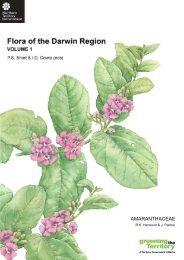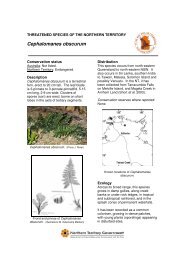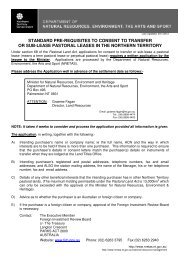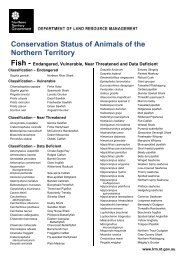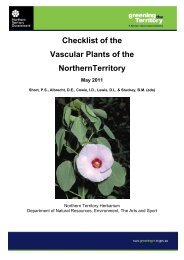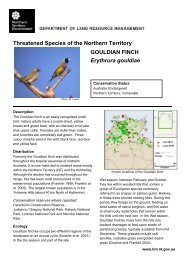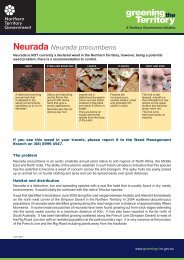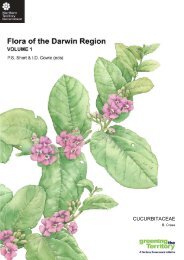DILLENIACEAE - Department of Land Resource Management ...
DILLENIACEAE - Department of Land Resource Management ...
DILLENIACEAE - Department of Land Resource Management ...
You also want an ePaper? Increase the reach of your titles
YUMPU automatically turns print PDFs into web optimized ePapers that Google loves.
2<br />
in 2 distinct groups, the outer ones c. 100, 7–<br />
8 mm long, straight in bud, the inner ones c. 18,<br />
11–13 mm long, with their apices reflexed in bud.<br />
Carpels 6–8, c. 10 mm long, 4 mm wide, deep<br />
crimson, with red styles, c. 14 mm long; ovules<br />
c. 8 per carpel. Fruit dehiscent, carpels 1–3-seeded.<br />
Seeds obovoid, c. 4 mm long, 3 mm wide, black,<br />
with reticulate surface, enclosed by waxy-white<br />
membranous aril. Flowering: June–Feb. Fruiting:<br />
Sept.–Oct.<br />
Fig. 1. (Dunlop 7431); Pl. 1 (unvouchered).<br />
Australia (N.T., Qld) and New Guinea. In the<br />
N.T. found in central and north-east Arnhem<br />
<strong>Land</strong>. Grows in rainforest but frequently occurs<br />
in wet situations in other types <strong>of</strong> forest,<br />
particularly on the coastal lowlands.<br />
*D. suffruticosa (Griff.) Martelli<br />
Shrub or tree to 10 m tall. Petiole 2–6 cm long,<br />
1.5 cm wide, the wings dilating upwards. Lamina<br />
elliptic to obovate, 13–25 cm long, 8–12 cm wide,<br />
margin entire to toothed, upper surface glabrous<br />
<strong>DILLENIACEAE</strong><br />
HIBBERTIA Andrews<br />
or sometimes slightly woolly on young leaves,<br />
lower surface slightly to densely woolly on the<br />
lateral nerves and on both sides <strong>of</strong> the central<br />
nerve. Inflorescence a terminal raceme or leafopposed,<br />
c. 5–12-flowered. Sepals 5, 15–22 mm<br />
long, 8–12 mm wide. Petals 5, obovate, 40–50 mm<br />
long, 25–30 mm wide, bright yellow. Stamens<br />
c. 175, the outer ones 8 mm long and straight in<br />
bud, the inner ones 13 mm long and with their<br />
apices reflexed in bud. Staminodes c. 100, 6 mm<br />
long. Carpels 5–8, usually 7, c. 5 mm long, 2 mm<br />
wide; styles yellowish-white, c. 1 cm long. Ovules<br />
7–10 per carpel. Fruit dehiscent. Seeds obovoid,<br />
c. 3 mm long, 2 mm wide, brown or black, with a<br />
membranaceous scarlet aril. Flowering & fruiting:<br />
probably throughout the year.<br />
Fig. 1 (Risler 2512).<br />
Native to Malesia and commonly cultivated<br />
elsewhere as an ornamental. In the D.R. there<br />
is some evidence that the species is naturalised<br />
in the rural area in wet situations.<br />
Shrubs, subshrubs or rarely vines, sometimes rhizomatous; stems in some species photosynthetic and<br />
these <strong>of</strong>ten flattened and sometimes dimorphic. Leaves spirally arranged, simple, entire or toothed,<br />
sometimes readily dehiscent or reduced to scales; stipules absent. Inflorescence usually solitary and axillary,<br />
or terminal. Sepals 5, <strong>of</strong>ten dimorphic, with an outer whorl <strong>of</strong> 2 sepals, an inner whorl <strong>of</strong> 2 sepals and a<br />
variable intermediate sepal. Petals 4 or 5, free, <strong>of</strong>ten bilobed, deciduous or persistent, yellow, pink, white<br />
or red. Stamens free or variously connate, all on one side <strong>of</strong> the carpels or surrounding the carpels and<br />
sometimes (with or without staminodes) in distinct whorls; filaments terete or manifestly flattened and<br />
sometimes with a bulbous base; anthers dehiscing via longitudinal slits or apical pores. Carpels (1) 2<br />
(–10), free or shortly connate on their inner edge; ovules 1–8 (25) per carpel; style filiform with minute<br />
terminal stigma. Fruit enclosed in the sepals, style and stamens persistent, usually 1 seed per carpel.<br />
Seeds reniform to globular, with or without an aril.<br />
A genus <strong>of</strong> c. 250 species, with most diversity in Australia, but also known from Madagascar, New<br />
Guinea, New Caledonia and Fiji. There are about 50 species in the N.T., with 28 species newly<br />
described by Toelken (2010) and an additional five species added to the genus following the placement<br />
<strong>of</strong> Pachynema R. Br. in synonymy (Horn 2009). There is a high degree <strong>of</strong> endemism in the N.T., with<br />
many species restricted to the western margin <strong>of</strong> the Arnhem <strong>Land</strong> Plateau.<br />
Variations in leaf hairs and scales are illustrated in Fig. 1.<br />
Taxonomic references: Hoogland (1952, 1983); Hyland et al. (2002); Horn (2007, 2009); Toelken (2010).<br />
1 Plant with distinct leaves throughout; stems neither photosynthetic<br />
or flattened .................................................................................................................... subgenus Hemistema<br />
1: Plant leafless or mostly so, any leaves present at or near the base <strong>of</strong><br />
the plant; stems photosynthetic and <strong>of</strong>ten flattened ............................................... subgenus Pachynema<br />
FDRV1 March 2011


